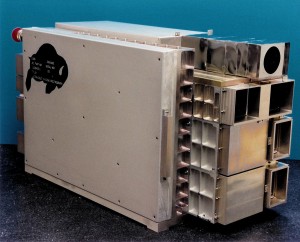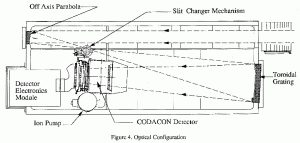Basic Description
The Instruments on UVIS, UVIS’s Job, and the Science of UV Light and Spectra
NOTE: Some of the more technical terms you’ll find below are defined in the UVIS Glossary. NASA also a great aerospace dictionary.

A Little Background on Ultraviolet Light and Spectra/spectrum
UVIS’s job is to measure Ultraviolet (UV) light, but first we need to understand what UV is to appreciate UVIS’s purpose.
UV light is part of the electromagnetic spectrum. A spectrum is a series of energies (like light) arranged according to wavelength, or frequency. The electromagnetic spectrum is an array of radiation that is divided into a number of sub-portions that ranges from the shortest cosmic rays, through gamma rays, X-rays, ultraviolet light, visible light, infrared radiation, microwave and other wavelengths of radio energy. Spectra is the plural of spectrum. We see a natural spectrum when we look at a rainbow.
Ultraviolet light (UV) is a portion of the electromagnetic spectrum that is a shorter wavelength than visible light; roughly it lies within a wavelength interval between 100 to 4000 angstroms. It is the same light you see coming out of a “black light” that makes fluorescent rocks glow bright colors. Most high-energy ultraviolet light is blocked by the ozone layer of the Earth, but some gets through and causes skin tanning. Extended exposure can lead to eye damage and skin cancer.
The UVIS Instrument’s Job on Cassini
The Ultraviolet Imaging Spectrograph Subsystem (UVIS) is a set of telescopes that measure ultraviolet (UV) light from Saturn, its rings and its moons. It also does a few other neat things we’ll talk about later.
UVIS is a remote sensing instrument (think sight–from very far away) that captures UV light reflected off objects, like Saturn’s rings or clouds, and turns it into images that it sends back to scientists on Earth. Studying these images helps us learn more about the structure (shape) and composition (what it’s made of) of these things as well as the particles in the atmosphere and their temperatures too.
The UVIS is a spectrograph, which measures wavelengths of light (spectra) and then displays the data as a graph. An imaging spectrograph, like UVIS, can also turn the points on the graph into digital data that can then be made into pictures. Because humans can’t see UV wavelengths of light, we assign different “false colors” to the different wavelengths that allows us to produce a picture out of the data that our eyes can appreciate. This representation simulates what a being with UV-sensitive eyes would see.
UVIS, which measures UV light between the wavelengths of 55.8 to 190 nm (or 558-1900 Å, or angstroms) , uses two different types of telescopes (EUV and FUV) to measure different levels of UV light.
As we said, the UVIS also does a few other things. There are a two other components of the UVIS, the High Speed Photometer Channel (HSP), and the Hydrogen-Dueterium Absorption Cell Channel (HDAC). These are explained below
The UVIS model found on this site, consists of pieces that represent each of the instruments on UVIS:
EUV
The Extreme Ultraviolet Channel (EUV) performs imaging spectroscopy and spectroscopic measurements of the structure and composition of the atmospheres of Titan and Saturn. It measures spectra between 55.8-118 nm (or 558-1180 Å) . The EUV consists of a telescope with a three-position slit changer, a baffle system, and a spectrograph with a CODACON microchannel plate detector and associated electronics.
FUV
The far ultraviolet channel (FUV) carries out imaging spectroscopy and spectroscopic measurements of the structure and composition of the atmospheres of Titan and Saturn and of the rings. It measures spectra between 110-190 nm (or 1100-1900 Å ). The FUV is similar to the EUV channel except for the grating ruling density, optical coatings, and detector details. The FUV electronics are similar to those for the EUV except for the addition of a high-voltage power supply for the ion pump. The ion pump maintains a vacuum inside the FUV channel. The EUV is open to space.
Both EUV and FUV ultraviolet channels are built into weight-relieved aluminum cases, and each contains a reflecting telescope, a concave grating spectrometer, and an imaging, pulse-counting detector.
HSP
The high-speed photometer channel (HSP) measures the amount of starlight and sunlight that peek through Saturn’s rings and around Titan and Saturn, when a star or the Sun is behind them (called an occultation). This helps us discover the vertical structure of clouds and gasses in the atmosphere and active processes that move the particles in Saturn’s rings.
The HSP performs stellar occultation measurements of the structure and density of material in the rings. The HSP measures light reflected from its own parabolic mirror with a photomultiplier tube detector.
HDAC
The hydrogen-deuterium absorption cell channel (HDAC) is used to measure hydrogen and deuterium in the Saturn system using a hydrogen cell, a deuterium cell, and a channel electron multiplier (CEM) detector to record photons not absorbed in the cells. Both cells are made of stainless steel coated with Teflon and are sealed at each end with MgF2 windows. This helps us understand the origin and history of Titan’s atmosphere.
Microprocessor Logic Assembly
All of these instruments are controlled by the Microprocessor Logic Assembly, which is the brain of the instrument. This computer tells the UVIS what and when to measure, and formats the data to be sent back to Earth.
The UVIS microprocessor electronics and control subassembly consists of input-output elements, power conditioning, science data and housekeeping data collection electronics, and microprocessor control elements.
Baseplate
All of these instruments are mounted onto a baseplate, which attaches the complete UVIS instrument to the Cassini spacecraft.


